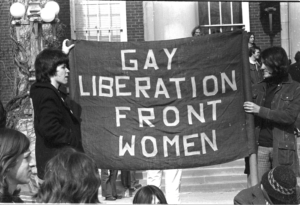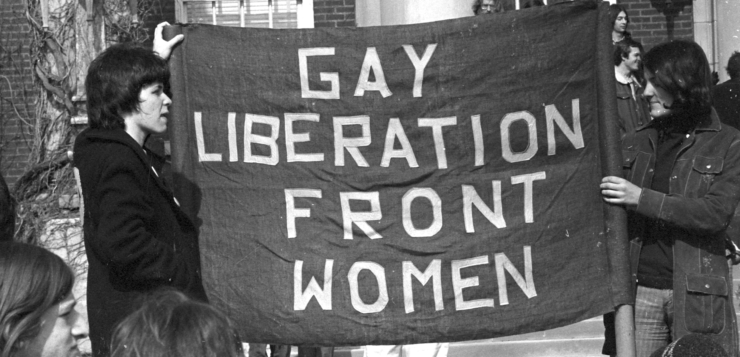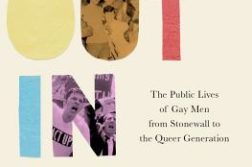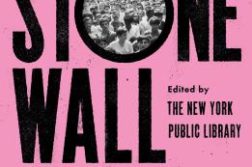FIFTY YEARS AGO a meeting changed my life. It was in early July 1969, shortly after Stonewall. I don’t remember the exact date or where it was held, only that a heated debate was taking place over whether the newly forming group, still nameless, should ally with the antiwar movement. Since I’d been involved in the movement against the Vietnam war since 1965, I jumped in on the side of the radicals, and we prevailed. The new group would be named the Gay Liberation Front (GLF), deliberately echoing the National Liberation Front (NLF) of Vietnam.
I was more than ready. As an adolescent I lived through the horrors of the McCarthy era, when gay men were outed, fired from jobs, and driven to suicide. At Harvard I read the few positive books that were available, including John Addington Symonds’ A Problem in Greek Ethics, Gide’s Corydon, and Plato’s Symposium. In Boston I got to know Prescott Townsend and attended meetings of the Boston Mattachine. After I moved to New York City I attended meetings of the Westside Discussion Group. I read One and Drum magazines (and still have some copies). In 1967 the Oscar Wilde Memorial Bookshop opened on Mercer Street, just a few blocks from where I lived, on St. Mark’s Place; there I bought a copy of Wainwright Churchill’s fine book, Homosexual Behavior Among Males: A Cross-Cultural and Cross-Species Investigation (1971).
But the GLF was a quantum leap forward from the earlier homophile movement. No more apologies or pleading for toleration. the GLF was ready to fight militantly for our freedom, and had the political savvy from the antiwar movement to do it. For the next few months every spare moment of mine was spent on the GLF. I passed out leaflets, helped build demonstrations, and worked on the dances. Almost every evening a few of us gay men would meet in the Silver Dollar, a dismally cheap restaurant on Christopher Street, to discuss what our goals should be. We strongly felt that “gay”—whose hidden meaning was still unknown to most straight people—should be the word to be used by others, as well as ourselves. It was not clinical like “homosexual,” timid like “homophile,” or hateful like “queer.”

My main efforts in these first few months were spent on Come Out!, the first newspaper of Gay Liberation. I was editor under Roslyn Bramms, who had formerly been managing editor of Screw magazine. The first issue was published on November 14, 1969.
The seeds of the GLF’s destruction were planted in the late fall of that year, when a group calling itself the “June 28 cell” pushed through a decision that the GLF should have no structure but consist of totally independent cells. Everybody should join a cell. No more voting—every decision had to be made by consensus (whatever that might be). All those attending even a single GLF meeting could consider themselves to be GLF members and could act on its behalf. The result was chaos. Without the ability to make decisions in an orderly and democratic manner, the GLF was no longer viable. The people in charge would be those best at behind-the-scenes machinations and shouting people down at meetings.
I can remember large meetings at an Episcopal church on the Lower West Side, where people screamed at each other and nothing got done. Since everyone had to form a cell, I and some others formed our own Marxist cell, which we whimsically named the Red Butterfly. In a way, we were the GLF’s radical intelligentsia, concerned with developing Gay Liberation theory. The Red Butterfly’s greatest success was its intervention in a huge antiwar conference in Cleveland on February 14th and 15th, 1970. We set up a table with the GLF banner, buttons, and our first pamphlet, “Gay Liberation.” For two days we were mobbed, as dozens of activists came out of the closet, and everyone wanted to know about the new movement. In the final meeting the conference voted to support its gay brothers and sisters.
It’s hard to sum up the GLF, since by 1970 it included hundreds of people, involved in all kinds of activities: communal living, “consciousness raising” (not my thing), demonstrations, writing, and more. The membership of the GLF was extremely heterogeneous. Members ranged from the top to the bottom of the social ladder; some had advanced degrees, others were barely literate. I knew fine, brave, creative people in the GLF, but also troublemakers and obstructionists.
Among those I got to know well were two young Englishmen: Andrew Hodges, a mathematician who would write the definitive biography of Alan Turing (Alan Turing: The Enigma, 1983); and Bob Mellors, who would co-found the London GLF. I formed a friendship with Arthur Evans that lasted until his death decades later. Arthur, appalled by the chaos in the GLF, became one of the three main founders of the Gay Activists Alliance (GAA) in December 1969.
The GLF finally collapsed in 1971. By then its place had been taken by the GAA, which was a strictly single-issue organization—gay rights only—and which conducted its meetings in an orderly manner following Robert’s Rules of Order. Even though I agreed with GAA in many ways, I stayed in the GLF, loyal to what I believed was its radical spirit and vision.
Looking back on Gay Liberation from the perspective of fifty years, I see that our main goal, getting rid of anti-sodomy statutes, has been accomplished. There have been many forward strides, especially a burgeoning gay scholarship. But there have also been steps backward. In none of the mainstream “lgbtq” organizations do I see any of the spirit and vision of GLF or GAA. The Gay Liberation goal of sexual freedom for all has been supplanted by identity politics. In the ’50s and early ’60s, Boston was one of the hottest cities in the world for gay-male sex; now it is dead, or so I’ve been told by those who are still sexually active. (I became an octogenarian earlier this month, and this no longer matters to me personally.) I think it will still be a long while before male homoeroticism is taken for granted as an ordinary and healthy part of the human experience.
John Lauritsen is co-author of The Early Homosexual Rights Movement (1864-1935). A section on Gay Liberation can be found on his website at paganpressbooks.com.





